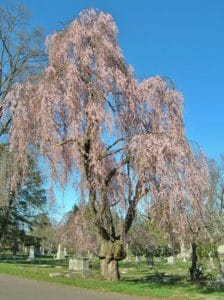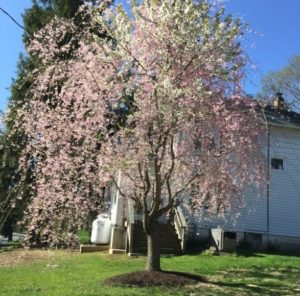Hello, fellow readers. What’s this about trees reverting back to their roots? Marcia from Columbia, NJ, sent a photo of her pink flowering weeping cherry. “There are two large boughs with pure white blossoms.” The tree looks like it has a spikey haircut as the white branches are sticking up while the rest of the tree gracefully weeps. “Should I cut the straight branches,” she asked.
Weeping Cherry trees are often grafted.
Weeping cherry trees are often top-grafted trees. The weepy part of the tree, the scion, is grafted onto the rootstock of what the trade calls a standard (a single trunk) to create the umbrella-like shape. Marcia’s tree rootstock is likely from a white flowering cherry.
Before pruning a weeping cherry, I read to confirm if it’s a natural or a grafted tree by looking for a graft knot on the trunk. Typically, it’s just below or about a foot under the crown (the branches). But I thought all weeping cherries were grafted, so on with the research cap.
Grafted versus Natural Weeping Cherry
My favorite nurseryman, Ben Jansen of Jansen Nursery in Florida, NY, said the reversion might be due to a poorly done graft or one that didn’t take well. He explained that the commonly sold Weeping Higan Flowering Cherry (Prunus subhirtella ‘Pendula’) is the hardier rootstock of Sargent Cherry (P. sargentii), a trunk of Yoshino Cherry (P. × yedoensis) and the canopy of Higan Cherry (P.subhirtella).
Ben suggested I reach out to J Frank Schmidt and Sons in Boring, Oregon, a wholesale grower well known for introducing new plants, to find out what a “naturally grown” weeping cherry is. Nancy Buley, their Communications Director, kindly gave me a crash course on how weeping cherry and other weeping trees are grown.
Why Weeping Cherries Weep
She explained weeping trees weep because “they don’t have apical dominance that makes plants stand upright.” They’d scramble on the ground if not trained to grow upright before weeping.

A mature Weeping Cherry with a large graft union. Photo: Msact at English Wikipedia, CC BY-SA 3.0 via Wikimedia Commons
“A natural weeping cherry (Prunus pendula), rather than grafted, grows on its natural (its own) root, rather than the rootstock of another cherry tree. We unnaturally get it to stand alone by staking it at whatever height we wish it to weep,” Nancy said.
How to prune branches of a reverting weeping cherry.
Naturally grown weeping cherry will not revert. The upward-growing branches will eventually arch down. If you prune them off, the tree will lose its weeping shape. So let them be.
But if a grafted tree, follow the straight branches to where they originate on the trunk and see if they’re below the graft union where the weeping part begins. If so, when the plant is dormant in late fall or early spring, prune the straight branches off at their origin with a clean cut. Messy cuts may inspire more sprouting from the same wound. If the straight stem is above the graft, let it grow to weep.
Because a newly reverted branch or stem tends to grow faster than the weeping ones, it’s best to cut them rather than wait too long, causing a gap or disfiguring the tree, taking years to fill in.
No Big Haircuts Please.
Regarding the length of the canopy, no big haircuts, please. Cut branches ideally no more than six inches off the ground, as severely shortening them may weaken the grafted part and encourage the rootstock to dominate. However, I can’t say that I blame the tree. There’s something comforting about returning to your roots.
Garden Dilemmas? AskMaryStone@gmail.com (and your favorite Podcast App.)
There’s more to the story in Episode 55 of the podcast:
About J Frank Schmidt and Sons and E. P. Jansen Nursery




Hello Mary, I have had an interesting experience with my weeping cherry. It had a very sparse top when planted two years ago and the first year’s growth didn’t thicken it at all. (My neighbour’s tree has a very dense weeping canopy.) Thinking that apical dominance may be involved I did a light winter prune of the longest branches. This spring (we are Southern Hemisphere) the upper branches, all above the graft, are putting out lots of growth, making me think that there is some form of dominance caused by longer branches. Interested in any comments you may have.
Best wishes and thank you for your article.
That’s interesting, Donn; it sounds like it could well be. Or maybe the tree needed time to settle in, putting energy into its roots rather than the canopy the first few years. I’m glad to hear your weeping cherry is growing into what sounds like a happy tree. Thank you for reading my column post, Mary Stone
Do you have an idea of where to purchase a natural weeping cherry tree in California or that will ship to California? The training part is what I do want. I’m not fond of the straight look the grafted trees have.
Hi Anna, I did a bit of internet searching and found this source: https://hollydaysnursery.com/product/prunus-pendula-weeping-cherry/. I’ve never purchased from them, but they say they have Prunus pendula. I suggest contacting them to be sure it’s the straight species and not grafted. Let me know how you make out. Thank you for reading my column! Mary Stone